When you load any style, all the components of that style are loaded and you can change some of those components as you play. For example, if you do not like the voice that is in RIGHT1, simply put another voice there. The right hand voices that are loaded with a style are saved in the styles one touch settings (OTS). You see the four OTS buttons on your keyboard and as you press each of these in turn, you can see the voices change on the MAIN screen.
If you want to change some of those voices, you can do so and save your changes in the relevant OTS button. Simply set the voices as you want and then press the [MEMORY] button and the OTS numbered button where you want this saved. If you would like to permanently keep your changes in the style's OTS setting, you need to save the style after you have altered the OTS settings. I will show you these steps with the DreamyBallad-j style I have been using as an example.
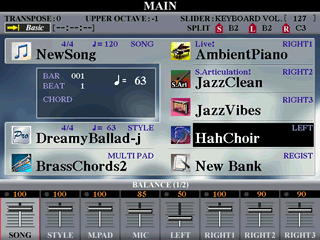 Here
is the MAIN screen showing the second OTS setting of the DreamyBallad-j style.
The style includes the HahChoir as the left-hand
voice although it is not turned ON. That left-hand voice is the same in all
four OTS settings. I normally like to play with the left-hand voice ON and
I want to replace this voice with one of the electronic piano voices. So,
I select the LEFT voice and open the VOICE display screen, move UP to
the different voice categories, and select the E.Piano folder, and then select
the GalaxyEP voice.
Here
is the MAIN screen showing the second OTS setting of the DreamyBallad-j style.
The style includes the HahChoir as the left-hand
voice although it is not turned ON. That left-hand voice is the same in all
four OTS settings. I normally like to play with the left-hand voice ON and
I want to replace this voice with one of the electronic piano voices. So,
I select the LEFT voice and open the VOICE display screen, move UP to
the different voice categories, and select the E.Piano folder, and then select
the GalaxyEP voice.
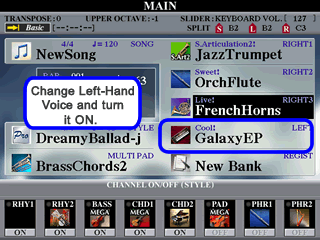 This
screen shot shows the fourth OTS with the new left-hand voice in place.
I've also turned the voice ON although that is not apparent from the MAIN
screen. You may also notice some other changes. I normally play with the
UPPER OCTAVE set at -1 (thus moving middle C up one octave on the keyboard).
I have also turned OFF the PAD, PHR1, and PHR2 voices. These aren't used
in OTS1 and OTS2, and make the style a bit too "busy" in OTS3 and
OTS4 for this style.
This
screen shot shows the fourth OTS with the new left-hand voice in place.
I've also turned the voice ON although that is not apparent from the MAIN
screen. You may also notice some other changes. I normally play with the
UPPER OCTAVE set at -1 (thus moving middle C up one octave on the keyboard).
I have also turned OFF the PAD, PHR1, and PHR2 voices. These aren't used
in OTS1 and OTS2, and make the style a bit too "busy" in OTS3 and
OTS4 for this style.
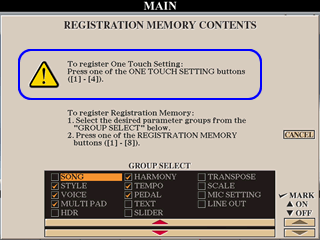 To
save my changes in the OTS setting, I press the [MEMORY] button on the keyboard
panel. This brings up the REGISTRATION MEMORY CONTENTS screen. This same
screen is shown whenever you press the [MEMORY] button for setting an OTS
or a Registration Memory button. Using the Registration Memory feature is
explained in detail in the section on Registrations.
For setting an OTS button, GROUP SELECT options shown on the bottom of this
screen can be ignored since they do not apply to the OTS. To save
your settings in OTS, ignore this screen and press the relevant OTS button.
To
save my changes in the OTS setting, I press the [MEMORY] button on the keyboard
panel. This brings up the REGISTRATION MEMORY CONTENTS screen. This same
screen is shown whenever you press the [MEMORY] button for setting an OTS
or a Registration Memory button. Using the Registration Memory feature is
explained in detail in the section on Registrations.
For setting an OTS button, GROUP SELECT options shown on the bottom of this
screen can be ignored since they do not apply to the OTS. To save
your settings in OTS, ignore this screen and press the relevant OTS button.
If you aren't specifying what to save in an OTS, just what does get saved? To answer that question you could refer to the "Parameter Chart" in the Tyros3 DataList manual (or the DataList manual for your keyboard). Among other things, it will tell you what specific parameters are saved in the OTS. I won't repeat all the details here, but can summarize the results by saying that virtually any parameter that deals with the right hand or left hand voice is saved in the OTS. This includes what voice is selected, whether it is on or off, the volume setting for that voice, all of the settings made in the Voice Set options, and all the voice related parameters in the Mixing Console. The OTS also remembers whether you have ACMP ON or OFF and whether SynchroStart is ON or OFF. In addition to all the voice parameers, your current MultiPad and the MultiPad volume are also saved. The fact that I have three of the accompaniment voices turned OFF is not saved in the OTS. For that, I would need to use the Registration Memory feature.
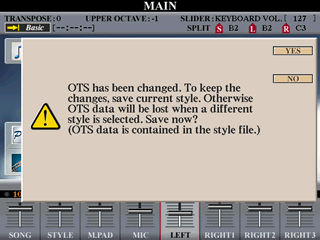 After
pressing the OTS button, I am shown a warning message alerting me to the
fact that the setting in the OTS button is not permanent. I need to save
the style to save these settings along with the style. If I don't, all
the current OTS settings are replaced with new ones if a different style
is loaded. I want to save the new LEFT voice in all four OTS buttons but
I don't have to save the style every time I change the OTS. I can
choose the NO option
and ignore this message until I get all four OTS buttons changed. Perhaps
I want to change some voices as well. So, I can go ahead and
make whatever changes I want in all 4 OTS buttons.
After
pressing the OTS button, I am shown a warning message alerting me to the
fact that the setting in the OTS button is not permanent. I need to save
the style to save these settings along with the style. If I don't, all
the current OTS settings are replaced with new ones if a different style
is loaded. I want to save the new LEFT voice in all four OTS buttons but
I don't have to save the style every time I change the OTS. I can
choose the NO option
and ignore this message until I get all four OTS buttons changed. Perhaps
I want to change some voices as well. So, I can go ahead and
make whatever changes I want in all 4 OTS buttons.
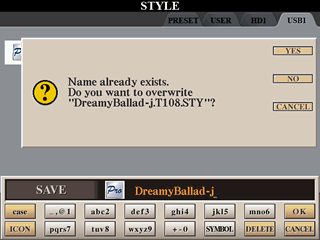 But
remember, the style has to be saved to make these OTS changes permanent.
So, when I'm done with my OTS changes, back at the MAIN screen, I press [D]
to open up the STYLE display screen, which will open up to the position
of my currently loaded style, and select the SAVE option.
The NAME input box opens with the name of the current style loaded. This
is, indeed, the style I am changing, so I press OK.
This will open up a confirmation screen alerting me to the fact that the
style name already exists and that I will be overwriting that style. This
is exactly what I intend to do, so I select YES in
answer to the prompt.
But
remember, the style has to be saved to make these OTS changes permanent.
So, when I'm done with my OTS changes, back at the MAIN screen, I press [D]
to open up the STYLE display screen, which will open up to the position
of my currently loaded style, and select the SAVE option.
The NAME input box opens with the name of the current style loaded. This
is, indeed, the style I am changing, so I press OK.
This will open up a confirmation screen alerting me to the fact that the
style name already exists and that I will be overwriting that style. This
is exactly what I intend to do, so I select YES in
answer to the prompt.
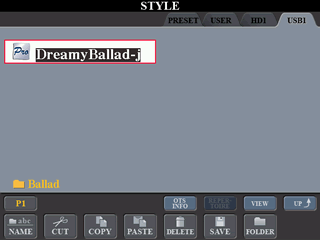 This
returns me to the STYLE display screen where I see "my" version
of this style on my USB drive in the Ballad folder.
This
returns me to the STYLE display screen where I see "my" version
of this style on my USB drive in the Ballad folder.
How do I know that this version has the OTS settings that I just changed? Notice at the bottom of the screen the OTS INFO button located right above the DELETE button. This button is unique to the STYLE display screen. It was introduced with the Tyros3 but is also available on the PSR-S910.
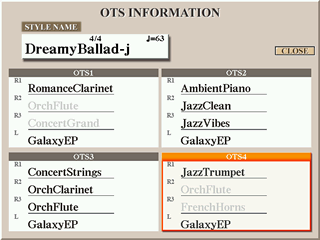 Pressing OTS INFO opens up the OTS INFORMATION screen. This shows you the name
of the style and the default tempo. It also shows you the voices used in
each of the four OTS setting. Voices that are not turned ON in the OTS are
shown grayed out. In this screen shot, I can see that the GalaxyEP voice
has, indeed, been saved in the LEFT voice and it is ON. I had also turned
OFF the RIGHT2 and RIGHT3 voices in OTS4 and, sure enough, they are shown
as being OFF.
Pressing OTS INFO opens up the OTS INFORMATION screen. This shows you the name
of the style and the default tempo. It also shows you the voices used in
each of the four OTS setting. Voices that are not turned ON in the OTS are
shown grayed out. In this screen shot, I can see that the GalaxyEP voice
has, indeed, been saved in the LEFT voice and it is ON. I had also turned
OFF the RIGHT2 and RIGHT3 voices in OTS4 and, sure enough, they are shown
as being OFF.
What's Next
OK, now you know how to load a style, modify the OTS, and save the modified version in your USER area, USB drive, or HD if you have a hard drive. For the final task, we'll show how you can save all of the preset multipads in a folder of your choice.
This page updated on September 19, 2024 .